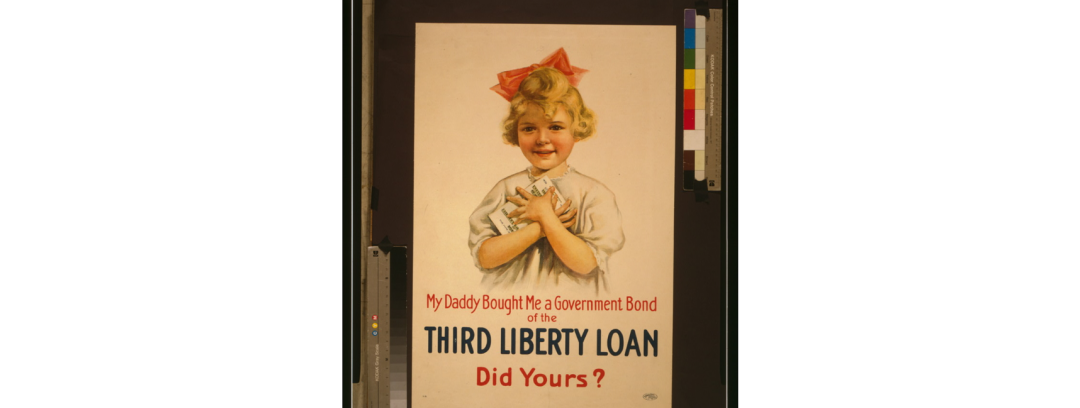When the Great War, also referred to as World War I, first erupted in Europe, America “remained neutral” on paper, yet provided supplies and financial assistance to the Allied Powers – France, Great Britain, and Russia.((D.E. Shi (2019). America: A Narrative History (Brief Eleventh Edition) (Vol. Volume 2). W.W. Norton)) However, after the sinking of various American ships in the Atlantic by German submarines and the interception of the Zimmerman telegram, America’s official stance of neutrality was rescinded, and they officially entered World War I. As an official Allied Power in the Great War, America shifted its production from civilian goods to war goods and in the process spent a lot of money. Furthermore, America had already lent almost two billion dollars to Allied Powers before entering the war, and as an official part of the war their spending greatly increased. In order to finance the war, President Woodrow Wilson and his administration raised taxes and even more importantly, launched campaigns to sell “liberty bonds”
President Wilson and his administration knew that they needed great financial assistance to win the war – meaning the liberty loan campaigns needed to be successful. In order to ensure the success of the Liberty Loan Plan, Secretary of the Treasury, William Gibbs McAdoo, composed the plan of various elements.((Richard, Sutch. “Liberty Bonds.” Federal Reserve History. Accessed November 9, 2021. https://www.federalreservehistory.org/essays/liberty-bonds.)) Perhaps the most crucial element of this plan was to connect the purchasing of liberty bonds to patriotism. The government knew that during a time of war, people wanted to help their country but most of them could not physically be across the Atlantic on the front lines. This led the government to advertise the purchasing of these liberty loans as an act of patriotism and a direct service to the United States of America.
One such of these advertisements was published in 1917 and was entitled My daddy bought me a government bond of the Third Liberty Loan–Did yours? This advertisement is in the form of a poster with a little girl on it. This little girl has blonde hair with a large red bow in it; she is a picturesque little American girl. The little girl is smiling and in her arms she is clutching a liberty bond from the third liberty loan.((My daddy bought me a government bond of the Third Liberty Loan–Did yours? / The United States Printing & Lithograph Co., New York. United States, 1917. Photograph. https://www.loc.gov/item/2002707404/.)) This third liberty loan was drafted in late 1917, with the United States government asking their people for $3,000,000,000. While this seems like a large amount, the American government felt like it was an attainable goal as the second liberty loan campaign was a success with over 9,420,000 men, women and children purchasing bonds.((Guaranty Trust Company of New York. War Loans of the United States and the Third Liberty Loan. [New York, etc.] Guaranty trust company of New York, 1918. https://search.ebscohost.com/login.aspx?direct=true&AuthType=sso&db=edshtl&AN=edshtl.MIU01.000971779&site=eds-live.)) Underneath the little girl in the advertisement is the words, “My daddy bought me a government bond of the Third Liberty Loan – Did yours?” Through this, the little girl in the poster is saying that her father is a patriot for having purchased a liberty bond for her and supporting the war cause. It is also important to note the fact that this little girl’s father bought her the bond – not her mother or both her parents. This is indicative of the fact that in the early twentieth century, women were still seen as inferior and relied on a male to support them financially. The intent of this poster advertisement was to have the reader feel somewhat guilty at not having purchased one. It was the hope of the creator of this poster – who is unfortunately unknown – that American citizens would see this and feel guilty for their lack of patriotism and then go to the nearest Federal Reserve bank and purchase a bond from the third liberty loan.
Overall, this poster advertisement (and others like it) must have had some level of accomplishment as the third liberty loan campaign was quite successful. From house-to-house canvassing in Pittsburgh alone, the National Woman’s Liberty Loan Committee sold third liberty loan bonds totaling $13,788,100.((National Woman’s Liberty Loan Committee. Report of National Woman’s Liberty Loan Committee for the Third Liberty Loan Campaign Apr. 6th-May 4th, 1918. Washington, [Govt. Print. Off.], 1918. https://search.ebscohost.com/login.aspx?direct=true&AuthType=sso&db=edshtl&AN=edshtl.MIU01.100243065&site=eds-live)) Through all five of the liberty loan campaigns, the United States government was able to raise two-thirds of the amount of money they spent in World War I.((“Granite State Stories: N.H. Raises $17 Million in Third Liberty Loan Campaign.” Concord Monitor. Concord Monitor, July 13, 2018. https://www.concordmonitor.com/Third-Liberty-Loan-Campaign-17980834.)) This success of the liberty loan campaigns was largely due to the connecting it to patriotism through advertising such as in the 1917 poster entitled My daddy bought me a government bond of the Third Liberty Loan–Did yours?
